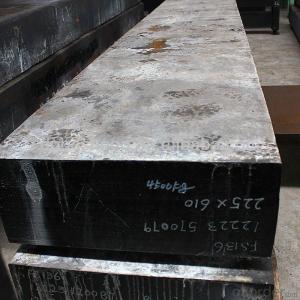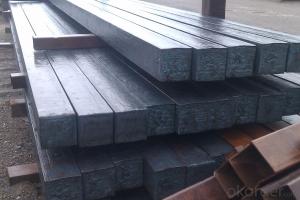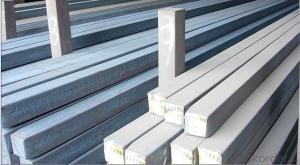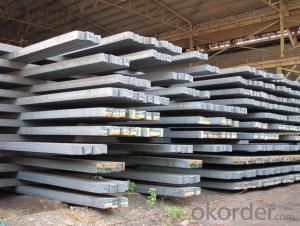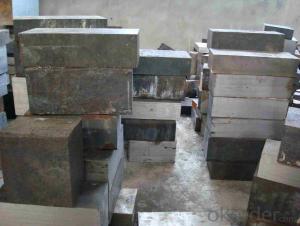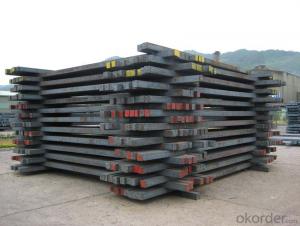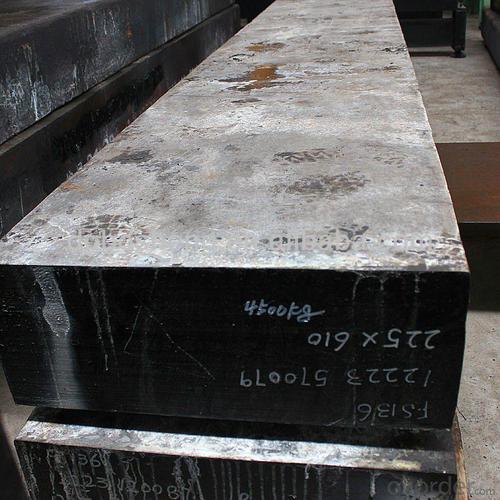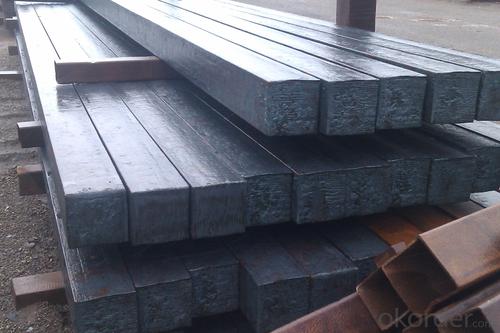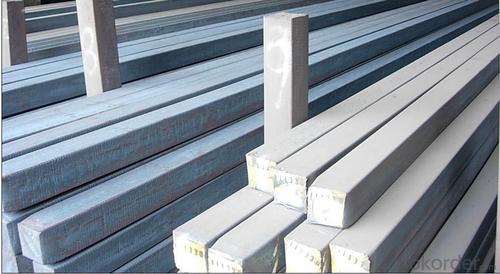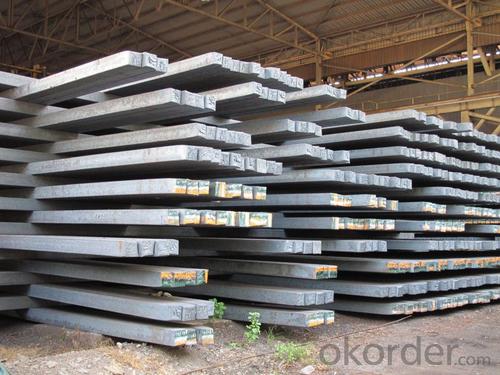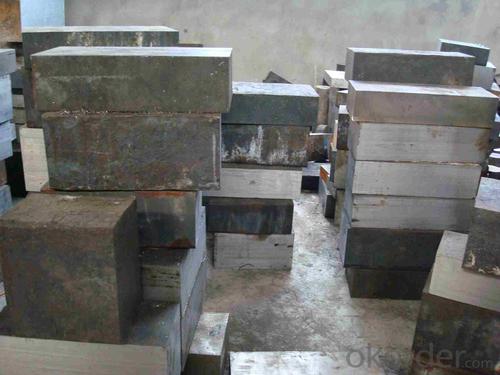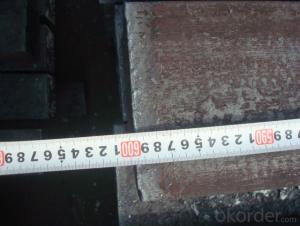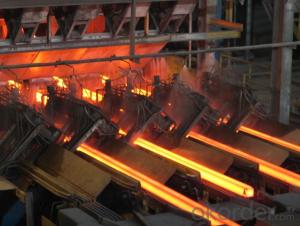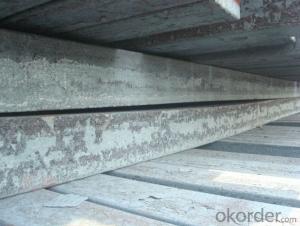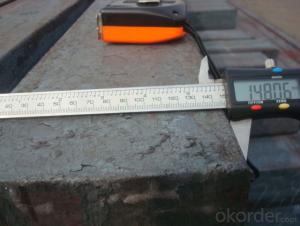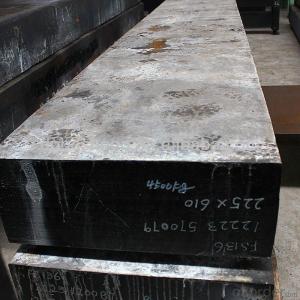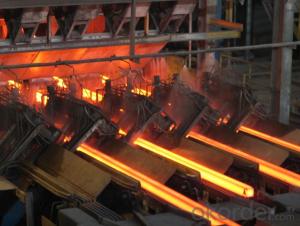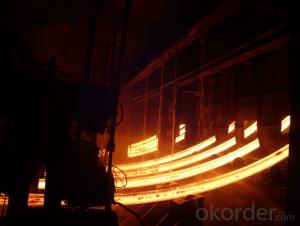Prime square alloy steel billet 115mm Q235
- Loading Port:
- Shanghai
- Payment Terms:
- TT OR LC
- Min Order Qty:
- 100 m.t.
- Supply Capability:
- 10000 m.t./month
OKorder Service Pledge
OKorder Financial Service
You Might Also Like
Structure of Prime square alloy steel billet 115mm Q235
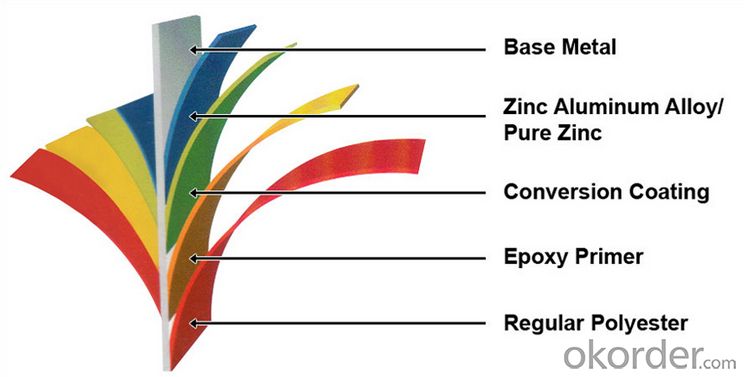
Description of Prime square alloy steel billet 115mm Q235
1) Excellent corrosion resistance: The zinc layer provides a good protection of Pre-painted Galvanizeed Steel Sheet.
2) High heat resistance: The reflective surface of the material aids in efficiently reflecting the sunlight away and in turn reducing the amount of heat transmitted. The thermal reflectivity converts into energy savings.
3) Aesthetics: Pre-Painted Galvanized steel sheet is available in plethora of patterns and multiple sizes as per the requirements that given by our customers.
4) Versatility: can be used in the various areas.
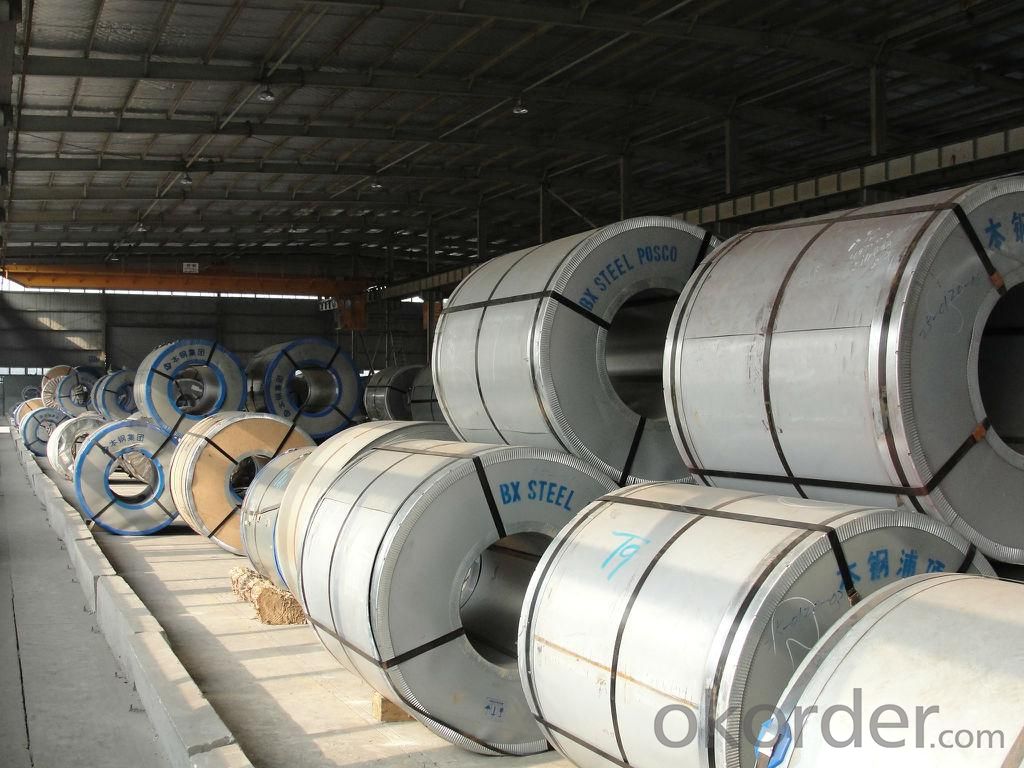
Main Feature of Prime square alloy steel billet 115mm Q235
Uncoated CR steel sheet
With the features of in line with the international highest standards in demension and shape, excellent surface finish and properties, the products are mainly used in home appliance and automobile industries.
Galvanized steel sheet(include HDG and EG)
With the features of good corrosion resistance, the products are mainly used in automobile, home appliance, electronics, building and machinery manufacture industries, etc.
Precoated steel sheet
With the features of enviromental protection and good processablility, long lasting surface durability, rich in colors, the products are maily used in building, home appliance and furniture industries, etc.
Applications of Prime square alloy steel billet 115mm Q235
1) Excellent corrosion resistance: The zinc layer provides a good protection of Pre-painted Galvanizeed Steel Sheet.
2) High heat resistance: The reflective surface of the material aids in efficiently reflecting the sunlight away and in turn reducing the amount of heat transmitted. The thermal reflectivity converts into energy savings.
3) Aesthetics: Pre-Painted Galvanized steel sheet is available in plethora of patterns and multiple sizes as per the requirements that given by our customers.
4) Versatility: can be used in the various areas.
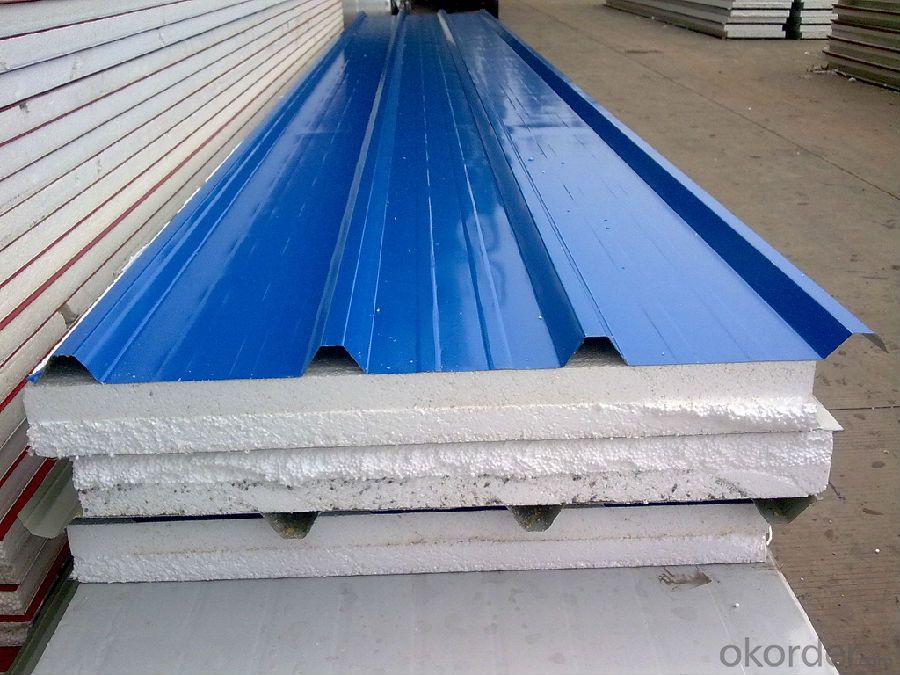
Specifications of Prime square alloy steel billet 115mm Q235
Product | Billet |
Material Grade | SGCC / SGCH / DX51D+AZ, etc |
Thickness | 0.6-3.0mm |
Width | 500-1500mm |
Tolerance | Thickness: +/-0.02mm , Width:+/-2mm |
Zinc-coating | Z30-150g/m2 |
Technique | Raw material: Hot rolled steel coil --> Cold rolled_>hot dipped galvalume |
Surface | Dried, Chromated, Unoiled |
Spangle | Regular spangle , small spangle, zero spangle |
ID | 508MM 610MM |
Coil weight | 1-25MT |
Export package | Cardboard inner sleeves, Waterproof paper, galvanized steel covered and steel strip packed |
FAQ of Prime square alloy steel billet 115mm Q235
We have organized several common questions for our clients,may help you sincerely:
1. How Can I Visit There?
Our company is located in Tianjin City, China, near Beijing. You can fly to Tianjin Airport Directly. All our clients, from home or aboard, are warmly welcome to visit us!
2. How Can I Get Some Sample?
We are honored to offer you sample.
3. Why choose CNBM?
we always fix steel produce in container well to make it safe arrive at destination port
we always provide best and professional forward service for our buyer
we always apply 14days free detention for our buyers container in destination
we provide one set After-sales service for our buyer
we provide China inland steel market price report
we help our buyer become number one in local market .
- Q: How are steel billets used in the manufacturing of power generation equipment?
- Steel billets are an essential raw material in the manufacturing of power generation equipment. These billets are large, rectangular or square-shaped semi-finished steel products that are cast from molten steel and then hot rolled or forged into their final shape. In the context of power generation equipment, steel billets are primarily used in the construction of turbine components, such as turbine blades and rotors, as well as in the fabrication of generator casings and other structural parts. The high strength and durability of steel make it an ideal material for these critical components, as they need to withstand high temperatures, pressure, and rotational forces. The process begins with the selection of an appropriate grade of steel billet, which depends on the specific requirements of the power generation equipment. The billets are then heated to a suitable temperature and forged or hot rolled to shape them into the desired form. This process involves precise machining, cutting, and shaping techniques to achieve the required dimensions and surface finish. Once the turbine components and other parts are formed from the steel billets, they undergo further treatments such as heat treatment, surface coating, and machining to enhance their mechanical properties and ensure their compatibility with the power generation system. The final products are then assembled into the power generation equipment, which may include gas turbines, steam turbines, wind turbine components, or generator sets. Steel billets play a crucial role in the manufacturing of power generation equipment by providing the necessary strength, durability, and performance required for efficient and reliable operation. The quality and precision in the production of steel billets directly impact the overall performance and longevity of the power generation equipment, making them a vital component in the industry.
- Q: How are steel billets measured and classified?
- Steel billets are typically measured and classified based on their dimensions, weight, and chemical composition. The dimensions of a billet, such as its length, width, and height, are measured to determine its size. The weight of the billet is determined by weighing it, either using a scale or by calculating its volume and density. Additionally, the chemical composition of the steel, including the percentage of elements like carbon, manganese, and silicon, is analyzed to classify the billet based on its grade or specific properties.
- Q: How are steel billets used in the manufacturing of oil and gas components?
- Steel billets are used in the manufacturing of oil and gas components as they serve as the raw material for various parts such as pipes, valves, flanges, and fittings. These billets are heated and then shaped through processes like extrusion, forging, or rolling to create the desired component. The strength, durability, and resistance to corrosion of steel make it an ideal material for oil and gas applications, ensuring the reliability and safety of the components used in the industry.
- Q: How are steel billets unloaded at the destination?
- Steel billets are typically offloaded at the destination using different techniques depending on the available infrastructure and equipment. One commonly used approach involves the utilization of cranes or forklifts that are equipped with lifting attachments. These machines have the capability to lift and move the heavy steel billets from the transport vehicle to the designated storage area or processing facility. In certain situations, a specialized unloading facility like a rail yard or port may be utilized. In these cases, cranes or gantry systems are often employed to efficiently transfer the steel billets from rail cars or shipping containers onto trucks or storage areas. This method allows for a more streamlined unloading process, especially when dealing with large quantities of steel billets. Another method that is sometimes employed involves the use of conveyor belts or rollers. This method proves particularly effective when unloading steel billets from a container or truck where they are arranged in a row. The conveyor belt or roller system permits a continuous unloading process, with the billets being moved along the conveyor to the desired location. Irrespective of the method employed, safety precautions are always implemented during the unloading process to ensure the well-being of workers and the prevention of any damage to the steel billets. These precautions may encompass the use of proper lifting techniques, securing the billets during transportation, and the wearing of appropriate personal protective equipment. In summary, the unloading of steel billets at the destination necessitates meticulous planning, efficient machinery, and adherence to safety protocols to ensure a smooth and successful operation.
- Q: How do steel billets contribute to the overall strength of a finished product?
- Steel billets are an essential component in the manufacturing process of various steel products, and they play a crucial role in determining the strength of the finished product. The strength of a final steel product is primarily dependent on the quality of the steel billets used. Firstly, steel billets are made by continuously casting molten steel into solid blocks or forms. This process ensures that the steel billets have a consistent and uniform structure, which is vital for maintaining the overall strength of the finished product. The uniformity of the steel billets allows for a more even distribution of stress and load-bearing capacity throughout the final product. Moreover, steel billets are usually made from high-quality steel alloys that are specifically chosen for their superior strength properties. These alloys typically contain elements such as carbon, manganese, and other alloying elements that enhance the overall strength and hardness of the steel. By using high-quality steel billets, manufacturers are able to produce finished products that exhibit excellent tensile and yield strength, making them more resistant to deformation, bending, and breaking. Additionally, steel billets undergo various heat treatment processes, such as quenching and tempering, which further enhance their strength. Quenching involves rapidly cooling the billets to increase their hardness, while tempering reduces the brittleness and improves their toughness. These heat treatment processes result in steel billets with improved mechanical properties, including higher yield strength and improved resistance to fatigue and impact. Furthermore, the size and shape of steel billets also contribute to the overall strength of the finished product. The dimensions of the billets determine the final dimensions of the product, and a larger billet size allows for a more substantial and stronger end product. Similarly, the shape of the billets can be optimized to improve the load-bearing capacity and structural integrity of the finished product. In conclusion, steel billets are critical to the overall strength of a finished product. Through their uniform structure, high-quality alloys, heat treatment processes, and optimized size and shape, steel billets provide the necessary foundation for the production of strong and durable steel products. Selecting the right steel billets and ensuring their quality throughout the manufacturing process are vital steps in creating a finished product with exceptional strength and performance.
- Q: What are the different types of surface defect detection methods for steel billets?
- Steel billets are subject to various methods of surface defect detection. Among the techniques commonly used are visual inspection, magnetic particle inspection, ultrasonic testing, eddy current testing, and laser scanning. 1. The simplest and most traditional method is visual inspection, where trained inspectors visually examine the surface of steel billets for cracks, scratches, or foreign material. 2. Magnetic Particle Inspection (MPI) is a non-destructive testing method that uses magnetic fields and iron particles to detect surface defects. The billet is magnetized, and iron particles are applied to the surface. Any defect causes a leakage of magnetic flux, attracting the iron particles and forming visible indications. 3. Ultrasonic Testing (UT) utilizes high-frequency sound waves to detect internal and surface defects in steel billets. Ultrasonic waves are emitted into the billet by a transducer, and the reflected waves are analyzed to identify flaws or irregularities. 4. Eddy Current Testing (ECT) makes use of electromagnetic induction to detect surface defects. A coil carrying an alternating current is placed near the billet's surface, generating eddy currents. Any variation in the surface, such as cracks or corrosion, alters the eddy currents, which are then detected by the instrument. 5. Laser Scanning is a relatively advanced method that employs laser technology to scan the surface of steel billets. The laser beam reflects off the surface, and a sensor analyzes the reflected light to identify surface defects like scratches or dents. These methods differ in terms of sensitivity, speed, and cost-effectiveness. The selection of the appropriate surface defect detection method depends on factors such as the required level of accuracy, the types of defects to be detected, and the specific requirements of the industry.
- Q: What are the disadvantages of using steel billets?
- Various industries face several drawbacks when using steel billets. Firstly, the weight and bulkiness of steel billets make them challenging to handle and transport. Consequently, logistical hurdles and costs can escalate, particularly when moving large quantities of billets. Secondly, the manufacturing process of steel billets necessitates a substantial amount of energy and resources. This includes melting iron ore and various additives, resulting in significant energy consumption and carbon emissions. Consequently, steel billets are less environmentally friendly compared to alternative materials. Moreover, steel billets have limited flexibility in terms of shape and size. They typically begin as long, rectangular bars, which restricts their usefulness in industries that require intricate or complex shapes. Consequently, additional steps and expenses are required to transform the billets into desired forms. Additionally, steel billets pose a high risk of surface defects and internal flaws. During production, impurities and non-uniformities can arise, leading to cracks, inclusions, or segregations within the billets. These defects jeopardize the structural integrity and performance of the final product, potentially resulting in failures or safety hazards. Lastly, steel billets are prone to corrosion, especially in harsh or corrosive environments. This significantly shortens their lifespan and necessitates frequent maintenance or protective coatings to prevent deterioration. Over time, the costs associated with corrosion prevention and maintenance accumulate, reducing the cost-effectiveness of steel billets in certain applications. In conclusion, while steel billets are widely utilized for their strength and durability, it is crucial to consider their disadvantages in terms of weight, energy consumption, limited flexibility, potential defects, and susceptibility to corrosion when selecting the appropriate material for a specific application.
- Q: What is the role of steel billets in the manufacturing of cutting tools?
- The manufacturing of cutting tools heavily relies on steel billets. These billets act as the primary material from which the cutting tool is forged or machined. Typically, steel billets are composed of high-quality steel alloys, which possess vital properties like hardness, toughness, and wear resistance that are necessary for cutting tools. To initiate the manufacturing process, the steel billets are heated to a specific temperature called the forging temperature. This temperature allows the steel to become malleable, making it easier to shape and mold into the desired cutting tool. The heated billets are then subjected to a forging process using specialized equipment, where they are struck or pressed to shape them into the desired form, such as drills, saws, or blades. Following the initial forging, the billets undergo further machining to refine their shape and dimensions. Machining processes like milling, turning, and grinding are employed to eliminate excess material, achieve precise dimensions required for the cutting tool, and create the desired cutting edge geometry. The quality of the steel billets used in the manufacturing process significantly impacts the performance and durability of the cutting tool. Steel billets with high carbon content and alloying elements like chromium, vanadium, or tungsten are often preferred as they enhance the hardness, strength, and wear resistance of the cutting tool. These properties are essential to ensure that the cutting tool can withstand the high forces, temperatures, and abrasive conditions it will encounter during use. In conclusion, steel billets serve as the foundation for manufacturing cutting tools. They provide the necessary raw material and properties required to create high-quality cutting tools that demonstrate exceptional performance, durability, and precision.
- Q: What is the role of steel billets in the manufacturing of automotive engine components?
- The production of automotive engine components relies heavily on steel billets, which are crucial in this process. These billets, essentially halfway finished steel items, act as the primary raw material for forging a variety of engine parts. The automotive industry has a high demand for engines that are efficient, durable, and capable of withstanding extreme conditions. Steel billets possess the necessary characteristics to meet these requirements. They are made from top-quality steel alloys, which exhibit exceptional strength, toughness, and resistance to heat. Once obtained, the steel billets go through a series of manufacturing processes to convert them into engine components like crankshafts, connecting rods, camshafts, and valve springs. Among these methods, forging is the most commonly used technique to shape the billets into these parts. During the forging process, the steel billets are heated to a specific temperature, making them more malleable. They are then subjected to high pressure, which molds them into the desired form. This process guarantees that the engine components possess the necessary strength and integrity to withstand the high stresses and temperatures experienced within an engine. One of the main advantages of utilizing steel billets in the production of automotive engine components is their ability to deliver superior performance and durability. Steel has a high tensile strength, enabling the engine parts to endure the intense forces and vibrations encountered during operation. Furthermore, steel's resistance to heat ensures that these components can withstand the elevated temperatures generated in the engine without deforming or failing. Aside from their mechanical properties, steel billets also offer cost-effectiveness in the manufacturing process. Steel is widely available and relatively inexpensive, making it an economically viable choice for mass production in the automotive industry. In conclusion, steel billets are indispensable in the production of automotive engine components due to their exceptional strength, durability, and resistance to heat. These semi-finished steel products serve as the basis for forging engine parts that can withstand the demanding conditions of automotive engines, ensuring the production of reliable and high-performance vehicles.
- Q: What is the weight of a standard steel billet?
- The dimensions and specific alloy composition of a standard steel billet can cause its weight to fluctuate. On average, the weight of a standard steel billet falls between 1,000 and 1,500 kilograms, equivalent to 2,204 and 3,307 pounds. It is worth mentioning that steel billets may have varying standard sizes and weight ranges depending on the industry and region.
Send your message to us
Prime square alloy steel billet 115mm Q235
- Loading Port:
- Shanghai
- Payment Terms:
- TT OR LC
- Min Order Qty:
- 100 m.t.
- Supply Capability:
- 10000 m.t./month
OKorder Service Pledge
OKorder Financial Service
Similar products
Hot products
Hot Searches
Related keywords
